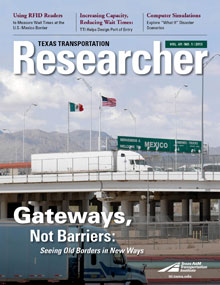As economies become more global, international urban centers like El Paso, Texas, face increasing pressure on their local transportation networks. These challenges drive the transportation research conducted by the Texas A&M Transportation Institute’s (TTI’s) Center for International Intelligent Transportation Research (CIITR). Research findings from CIITR staff often provide the foundation upon which public- and private-sector stakeholders build new opportunities for improving and expanding international trade and tourism. Overarching goals of CIITR research projects include:
- Maintaining and improving mobility in the face of growing congestion and shrinking resources.
- Increasing border-crossing efficiency while maintaining security.
- Improving air quality to advance personal health.
In each of these missions, example projects for which are provided here, CIITR is committed to enhancing the quality of life for the Paso Del Norte Region and helping to develop solutions at the U.S.-Mexico border that help ensure the safe, secure and efficient movement of people and goods.
Understanding Traffic Trends to Facilitate Commerce

Recent negative changes in the global economy have resulted in a significant decline in trade and freight movement worldwide. Stakeholders in the United States want to know how these changes will affect foreign trade and freight movement across our borders.
Since 2009, CIITR personnel have studied freight activities across ports of entry at the border and constructed an annual research brief. Using monthly data from the Trans-Border Surface Freight Database of the U.S. Bureau of Transportation, they have identified trends and quantified variations in freight movement across the U.S.-Mexico border. The study classifies freight by mode of transport (trucks and rail cars, empty and loaded), commodities (six commodity groups) and freight destinations. The research results from this project help public- and private-sector stakeholders from El Paso and other border regions by providing them with more accurate information regarding freight movements, which helps decision makers in allocating resources to support border-crossing operations and activities.
Understanding How Border Delays Impact Consumer Travel

Destination studies can help businesses on both sides of the border anticipate customer volume and thereby impact the volume of goods they keep on their shelves, the prices of those goods and ultimately economic growth in a region. Supporting the economic development of both Ciudad Juárez and El Paso, the Paso del Norte Bridge is one of the busiest border pedestrian crossings between Texas and Mexico. Over the last several years, pedestrian traffic has fallen significantly, partially due to long wait times at border crossings. Although the effects of border delays on commercial and passenger vehicle cross-border traffic have been extensively studied, little is known about their effect on pedestrian cross-border travel. This problem has become so severe in the Paso del Norte region, in fact, that economic growth is suffering. Understanding changes in pedestrian traffic trends is critical for retail business owners to efficiently conduct business and for local economic development officials to proactively address border-crossing operations.
To assist entrepreneurs and local government officials in developing strategies to improve the flow of pedestrians and customers across the border, CIITR researchers studied the implications of border delays on the choices of individual cross-border travelers, their choice of transportation mode to cross the border, and ultimately their decisions to cross the border for work, shopping or leisure, if at all. Knowing these motives can provide policy makers with data for proposing strategies to improve pedestrian traffic flow, and can aid businesses in better understanding and predicting the future travel behavior of their customers. The study’s findings will also offer insights into how to alleviate border-crossing wait times for pedestrians and provide local communities with valuable data regarding these delays to use in planning their region’s economic sustainability.
Developing More Precise Emissions Estimates for Clean Air Act Compliance

The El Paso area is currently in nonattainment of the Environmental Protection Agency’s (EPA’s) Clean Air Act standards and deadlines for particle pollution and is on the verge of being in nonattainment for carbon monoxide emissions. El Paso’s continued noncompliance risks losing federal highway funds. To demonstrate compliance, nonattainment areas must develop accurate emissions estimates that can be used to prove compliance with EPA standards.
Border-crossing cities have unique air-quality characteristics not well accounted for in current emissions estimation models. Center researchers are developing a robust methodology to estimate emissions that accounts for the overall impact of cross-border vehicle activity and how control strategies would impact emissions. To develop this unique estimation tool, researchers reconciled gaps in emissions estimation methodologies for border-crossing activities and developed a way to extract second-by-second emissions rates from the Motor Vehicle Emission Simulator model and real-world emissions measurements.
This new methodology will help the El Paso area and other border communities accurately assess the impact of control strategies and future port-of-entry improvements, and provide guidance for their decision-making processes. Specifically, communities can use CIITR’s research product to quantify the pollution impact of cross-border vehicle traffic, ultimately helping them demonstrate compliance with EPA standards and retain federal funding as a result.


